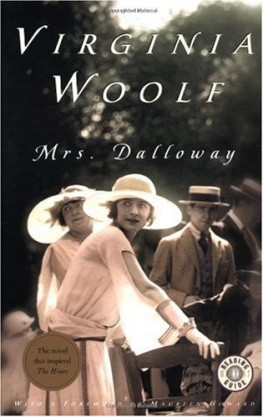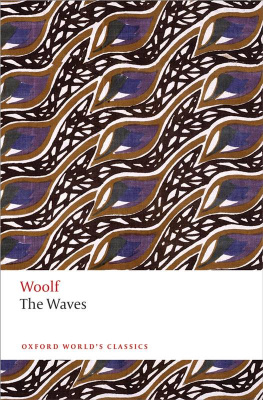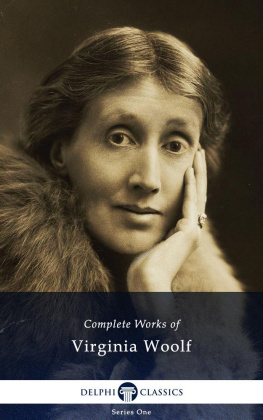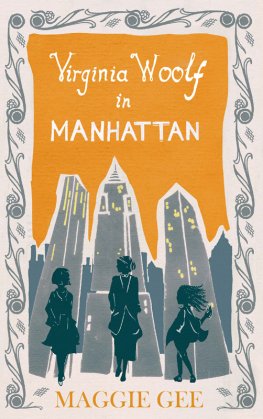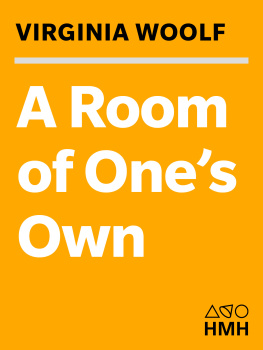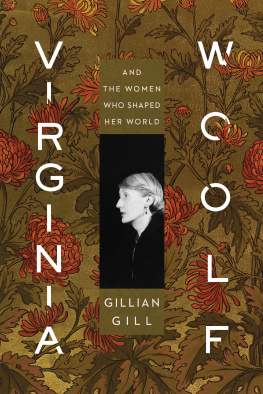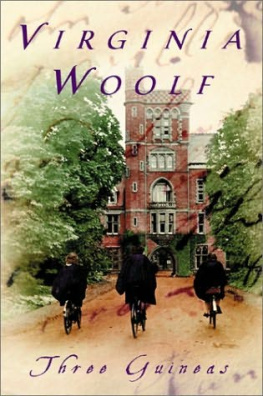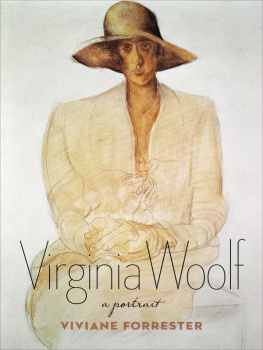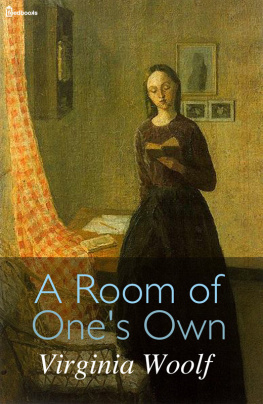Virginia Woolf - A Room of Ones Own and Three Guineas
Here you can read online Virginia Woolf - A Room of Ones Own and Three Guineas full text of the book (entire story) in english for free. Download pdf and epub, get meaning, cover and reviews about this ebook. year: 2014, publisher: OUP Oxford, genre: Art. Description of the work, (preface) as well as reviews are available. Best literature library LitArk.com created for fans of good reading and offers a wide selection of genres:
Romance novel
Science fiction
Adventure
Detective
Science
History
Home and family
Prose
Art
Politics
Computer
Non-fiction
Religion
Business
Children
Humor
Choose a favorite category and find really read worthwhile books. Enjoy immersion in the world of imagination, feel the emotions of the characters or learn something new for yourself, make an fascinating discovery.
- Book:A Room of Ones Own and Three Guineas
- Author:
- Publisher:OUP Oxford
- Genre:
- Year:2014
- Rating:5 / 5
- Favourites:Add to favourites
- Your mark:
- 100
- 1
- 2
- 3
- 4
- 5
A Room of Ones Own and Three Guineas: summary, description and annotation
We offer to read an annotation, description, summary or preface (depends on what the author of the book "A Room of Ones Own and Three Guineas" wrote himself). If you haven't found the necessary information about the book — write in the comments, we will try to find it.
A Room of Ones Own and Three Guineas — read online for free the complete book (whole text) full work
Below is the text of the book, divided by pages. System saving the place of the last page read, allows you to conveniently read the book "A Room of Ones Own and Three Guineas" online for free, without having to search again every time where you left off. Put a bookmark, and you can go to the page where you finished reading at any time.
Font size:
Interval:
Bookmark:

OXFORD WORLDS CLASSICS
A ROOM OF ONES OWN
AND
THREE GUINEAS
ANNA SNAITH is Professor of Twentieth-Century Literature at Kings College London. She is the author of Virginia Woolf: Public and Private Negotiations (2000), Modernist Voyages: Colonial Women Writers in London 18901940 (2014), and editor of the Cambridge University Press Edition of Virginia Woolfs The Years (2012) and Locating Woolf: The Politics of Space and Place (with Michael Whitworth 2007).
OXFORD WORLDS CLASSICS
For over 100 years Oxford Worlds Classics have broughtreaders closer to the worlds great literature. Now with over 700titlesfrom the 4,000-year-old myths of Mesopotamia to thetwentieth centurys greatest novelsthe series makes availablelesser-known as well as celebrated writing.
The pocket-sized hardbacks of the early years containedintroductions by Virginia Woolf, T. S. Eliot, Graham Greene,and other literary figures which enriched the experience of reading.Today the series is recognized for its fine scholarship andreliability in texts that span world literature, drama and poetry,religion, philosophy, and politics. Each edition includes perceptivecommentary and essential background information to meet thechanging needs of readers.

Great Clarendon Street, Oxford, OX2 6DP,
United Kingdom
Oxford University Press is a department of the University of Oxford. It furthers the Universitys objective of excellence in research, scholarship, and education by publishing worldwide. Oxford is a registered trade mark of Oxford University Press in the UK and in certain other countries
Introduction, Select Bibliography, Explanatory Notes Anna Snaith 2015 Biographical Preface Frank Kermode 1992
Chronology David Bradshaw 2000
The moral rights of the author have been asserted
First published as a Worlds Classics paperback 1992
Reissued as an Oxford Worlds Classics paperback 1998, 2008
New edition 2015
Impression: 1
All rights reserved. No part of this publication may be reproduced, stored in a retrieval system, or transmitted, in any form or by any means, without the prior permission in writing of Oxford University Press, or as expressly permitted by law, by licence or under terms agreed with the appropriate reprographics rights organization. Enquiries concerning reproduction outside the scope of the above should be sent to the Rights Department, Oxford University Press, at the address above
You must not circulate this work in any other form and you must impose this same condition on any acquirer
Published in the United States of America by Oxford University Press 198 Madison Avenue, New York, NY 10016, United States of America
British Library Cataloguing in Publication Data
Data available
Library of Congress Control Number: 2014949002
ISBN 9780191009334
Printed in Great Britain by
Clays Ltd, St Ives plc
Links to third party websites are provided by Oxford in good faith and for information only. Oxford disclaims any responsibility for the materials contained in any third party website referenced in this work.
VIRGINIA WOOLF was born Adeline Virginia Stephen on 25 January 1882 at 22 Hyde Park Gate, Kensington. Her father, Leslie Stephen, himself a widower, had married in 1878 Julia Jackson, widow of Herbert Duckworth. Between them they already had four children; a fifth, Vanessa, was born in 1879, a sixth, Thoby, in 1880. There followed Virginia and, in 1883, Adrian.
Both of the parents had strong family associations with literature. Leslie Stephen was the son of Sir James Stephen, a noted historian, and brother of Sir James Fitzjames Stephen, a distinguished lawyer and writer on law. His first wife was a daughter of Thackeray, his second had been an admired associate of the Pre-Raphaelites, and also, like her first husband, had aristocratic connections. Stephen himself is best remembered as the founding editor of the Dictionary of National Biography, and as an alpinist, but he was also a remarkable journalist, biographer, and historian of ideas; his History of English Thought in the Eighteenth Century (1876) is still of great value. No doubt our strongest idea of him derives from the character of Mr Ramsay in To the Lighthouse; for a less impressionistic portrait, which conveys a strong sense of his centrality in the intellectual life of the time, one can consult Nol Annans Leslie Stephen (revised edition, 1984).
Virginia had the free run of her fathers library, a better substitute for the public school and university education she was denied than most women of the time could aspire to; her brothers, of course, were sent to Clifton and Westminster. Her mother died in 1895, and in that year she had her first breakdown, possibly related in some way to the sexual molestation of which her half-brother George Duckworth is accused. By 1897 she was able to read again, and did so voraciously: Gracious, child, how you gobble, remarked her father, who, with a liberality and good sense at odds with the age in which they lived, allowed her to choose her reading freely. In other respects her relationship with her father was diffcult; his deafness and melancholy, his excessive emotionalism, not helped by successive bereavements, all increased her nervousness.
Stephen fell ill in 1902 and died in 1904. Virginia suffered another breakdown, during which she heard the birds singing in Greek, a language in which she had acquired some competence. On her recovery she moved, with her brothers and sister, to a house in Gordon Square, Bloomsbury; there, and subsequently at several other nearby addresses, what eventually became famous as the Bloomsbury Group took shape.
Virginia had long considered herself a writer. It was in 1905 that she began to write for publication in the Times Literary Supplement. In her circle (more loosely drawn than is sometimes supposed) were many whose names are now half-forgotten, but some were or became famous: J. M. Keynes and E. M. Forster and Roger Fry; also Clive Bell, who married Vanessa, Lytton Strachey, who once proposed marriage to her, and Leonard Woolf. Despite much ill health in these years, she travelled a good deal, and had an interesting social life in London. She did a little adult-education teaching, worked for female suffrage, and shared the excitement of Roger Frys Post-Impressionist Exhibition in 1910. In 1912, after another bout of nervous illness, she married Leonard Woolf.
She was thirty, and had not yet published a book, though The Voyage Out was in preparation. It was accepted for publication by her half-brother Gerald Duckworth in 1913 (it appeared in 1915). She was often ill with depression and anorexia, and in 1913 attempted suicide. But after a bout of violent madness her health seemed to settle down, and in 1917 a printing press was installed at Hogarth House, Richmond, where she and her husband were living. The Hogarth Press, later an illustrious institution, but at first meant in part as therapy for Virginia, was now inaugurated. She began Night and Day, and finished it in 1918. It was published by Duckworth in 1919, the year in which the Woolfs bought Monks House, Rodmell, for 700. There, in 1920, she began Jacobs Room, finished, and published by the Woolfs own Hogarth Press, in 1922. In the following year she began
Next pageFont size:
Interval:
Bookmark:
Similar books «A Room of Ones Own and Three Guineas»
Look at similar books to A Room of Ones Own and Three Guineas. We have selected literature similar in name and meaning in the hope of providing readers with more options to find new, interesting, not yet read works.
Discussion, reviews of the book A Room of Ones Own and Three Guineas and just readers' own opinions. Leave your comments, write what you think about the work, its meaning or the main characters. Specify what exactly you liked and what you didn't like, and why you think so.



